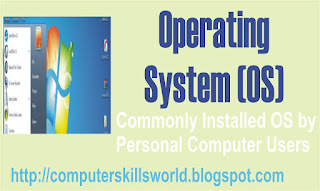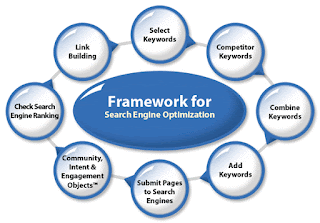This is called the system software because it is the software that provides the infrastructures on which other computer programs/applications (runs). It is the most important software in a computer.
There are different types of Operating System (OS). Dome of them are premium software while others are either free or open source software. Both the premium and open source OS have similar functions but with varying capacities and uniqueness.
The following are the most common premium operating systems in no particular order.
- Windows OS
- Mac OS
- Google Chrome OS
- Android OS (Mainly for Phones and Tablets)
Windows Operating System
Windows Operating System is designed by Microsoft Corporation and primarily targeted to Intel architecture based computers. It is the most licensed Windows Operating System in the history of personal computers.It was first released in 1985, as an operating environment running on top of MS-DOS, which was the standard operating system shipped on most Intel architecture personal computers at the time. In 1995, Windows 95 was released which only used MS-DOS as a bootstrap.
Over the years, Windows Operating System families now have newer editions like Windows XP, Windows 7, Windows 8, and Windows 10 and many Windows Server OS.
Mac Operating System
macOS is a line of open core graphical operating systems developed, marketed, and sold by Apple Inc. , the latest of which is pre-loaded on all currently shipping Macintosh computers.It is the successor to the original classic Mac OS, which had been Apple's primary operating system since 1984. Unlike its predecessor, macOS is a UNIX operating system built on technology that had been developed at NeXT through the second half of the 1980s and up until Apple purchased the company in early 1997.
Google Chrome Operating System
This is an operating system based on the Linux kernel and designed by Google. It is developed out of the open in the Chromium OS open source variant and Google makes a proprietary variant of it.It will interest you to know that Chromium OS targets computer users who spend most of their time on the Internet, and hence it is mainly a web browser with limited ability to run local applications, but has a built-in file manager, media player, and Android apps support.
It mainly relies on Internet applications used in the web browser to accomplish tasks such as word processing and it is the operating system shipped out in Chromebooks.
Android Operating System
This is mainly for Phones and Tablets. It is a mobile operating system developed by Google, based on the Linux kernel and designed primarily for touch screen mobile devices such as smart phones and tablets.It user interface is mainly based on direct manipulation, using touch gestures that loosely correspond to real-world actions, such as swiping, tapping and pinching, to manipulate on-screen objects, along with a virtual keyboard for text input.
In addition to smart phones devices, Google has further developed Android TV for televisions, Android Auto for cars and Android Wear for wrist watches, each with a specialized user interface. variants of the Android OS. It is also the OS used on notebooks, game consoles, digital cameras, and some other electronics.
The following are the most common free or open source operating systems in no particular order.
- Unix OS
- Linux OS
- Ubuntu OS
Unix Operating System
Unix was originally written in assembly language. It was later rewritten in C, developed into a large, complex family of inter-related operating systems which have been influential in every modern operating system.Note that the Unix-like family is a diverse group of operating systems, with several major sub- categories including System V, BSD, and Linux. "UNIX-like" is a term commonly used to refer to the large set of operating systems which resemble the original UNIX.
Linux Operating System
Linux is UNIX-like operating system. The Linux kernel originated in 1991, as a project of Linus Torvalds, while a university student in Finland. He posted information about his project on a newsgroup for computer students and programmers, and received support and assistance from volunteers who succeeded in creating a complete and functional kernel.Although Linux is Unix-like, it was developed without any Unix code, unlike BSD and its variants and because of its open license model, the Linux kernel code is available for study and modification, which resulted in its use on a wide range of computing machinery from supercomputers to smart-watches.
Ubuntu Operating System
Ubuntu is a Debian-based Linux operating system, with Unity as its default desktop environment. It is built on Debian 's architecture and infrastructure, to provide Linux server, desktop, phone, tablet and TV operating systems with an operating system.It releases updated versions predictably every six months and each release then receives free support for nine months in the following areas:
- Security fixes
- High-impact bug fixes
- Conservative and substantially beneficial low-risk bug fixes.
Any of these operating systems can definitely satisfy your OS need depending on the kind of computer user you are.
Although, for the sake of software programs or applications compatibility, it is always better to go for the popular and most commonly used ones like Windows OS, Mac OS, and Linux OS.
You can check out my book which is Live on Amazon.
Operating System is system software that manages computer hardware and application programs. It is the most important software that runs on a computer; while Windows Operating System which is a graphical user interface operating system developed by Microsoft is the operating system most personal computer users installed on their computers.
With this book, you will quickly learn and acquire the skills to understand and effectively get the best from your Windows Operating System Personal computer. These are what you will learn:
*Introduction to Operating System
*Windows Operating System Overview
*Windows Operating System Installation
"Basic Windows Operating System Operations (Tasks)
*Control Panel applets and their functions
*Disk Defragment
*Disk Partitioning
"Windows Operating System Upgrade
*System Restore
*How to Clean up a Virus Infested Personal Computer
*Disk Formatting
Add any feedback you have using the comment box on this post.
Related posts
Android Application Development Tools
An Introduction to Computer Software
You can also check out this my blog post here if you need any further clarifications on the Payoneer Bank account opening and entering the account details in your Amazon KDP account.



















